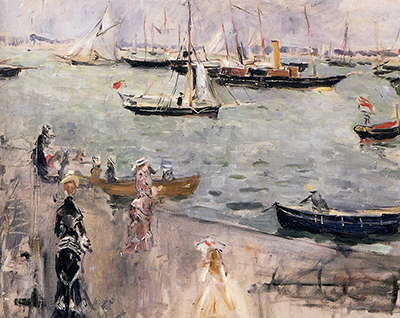The Isle of Wight is a charming seascape by Berthe Morisot which captures the harbour side of this popular island which is situated just off the coast of the English mainland. See also Eugene Manet on the Isle of Wight.
This composition looks out across the harbour with a small path cutting across in the foreground. Several attractively-dressed women look out to see a large number of boats placed across the scene. Several small fishing boats cater to small children and mothers, and these are attached to the shore nearest us. There is then a number of large commercial vessels which would be used for a variety of purposes such as fishing and sailing. All of this detail is incorporated with the minimum of fuss by Morisot, with reduced brushstrokes which is entirely typical of her Impressionist approach. A few dabs of paint are used to signify the waves, but generally we are given a fairly calm atmosphere, in which relatively few figures are actually included. This is a time at which most of the boats are resting before their next voyage and appear to be un-manned in the main.
The artist would marry Eugene Manet in late 1874, with their honeymoon being spent on the Isle of Wight. It is there likely that this painting would have been completed in the very early part of 1875, whilst they were staying here, or perhaps from a studio back in France at a later date. This would have meant drawings being made at the time which could then be used later on, but the whole atmosphere of this stunning piece suggests that she worked directly in oils or watercolours for this piece whilst staying there. The Manets featured regularly within her work and provided another family connection within the Impressionist movement.
This depiction of the Isle of Wight is sized at 48cm by 36cm and is a part of a private collection today. This perhaps explains why other paintings that she produced on this island have been given more exposure, perhaps simply because they have been more readily available to researchers and academics. The item mentioned here which featured Eugene Manet would also have carried extra value because of the significance of this individual, where as the seascape displayed here features anonymous figures within a fairly generic harbour scene. The late 19th century marked the point at which more of the upper and middle classes were starting to enjoy leisure time and holidays were an important part of that. Artists such as those in the Impressionist movement were keen to capture some of these events and reflect the changing society of that era.




